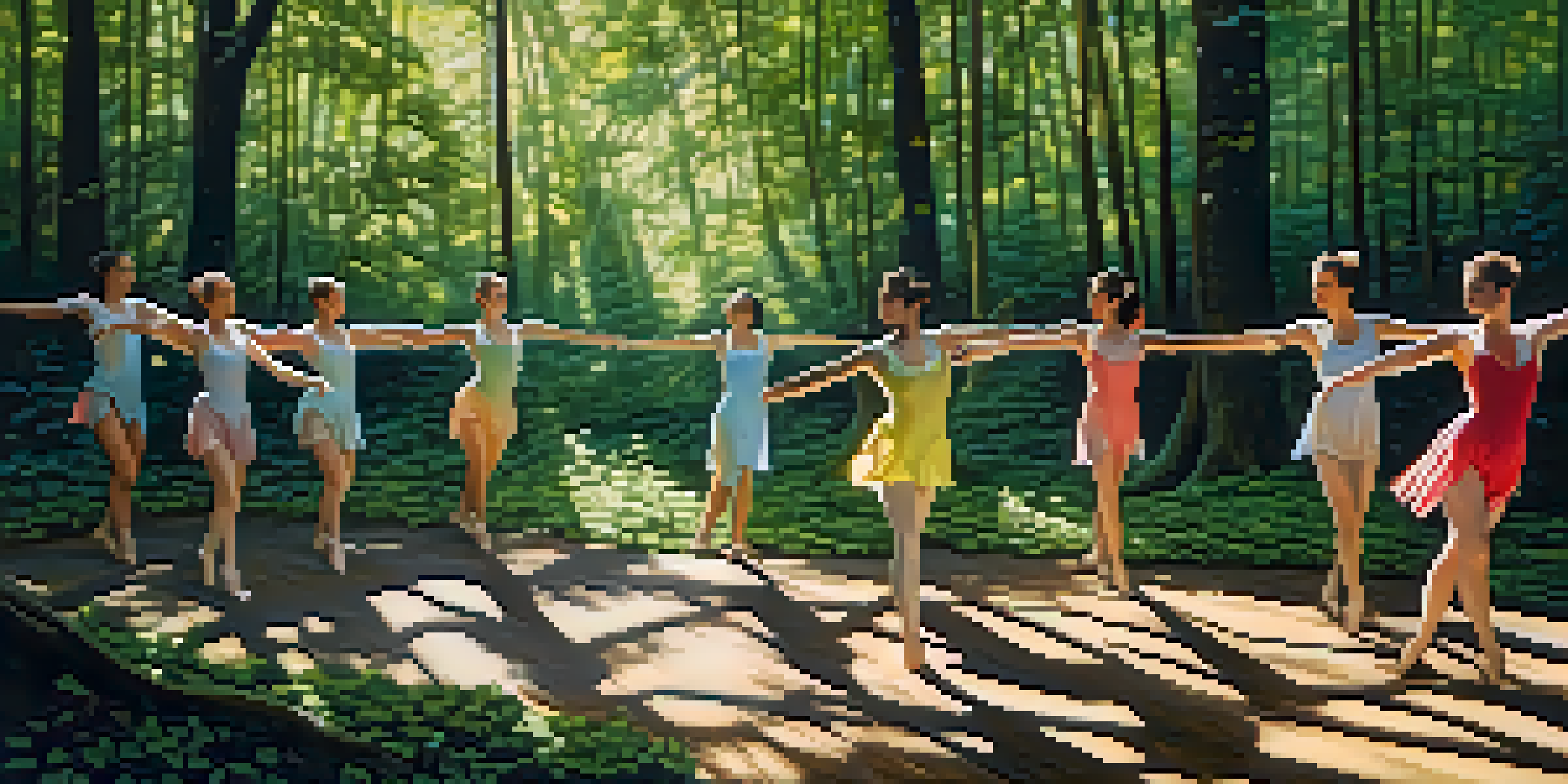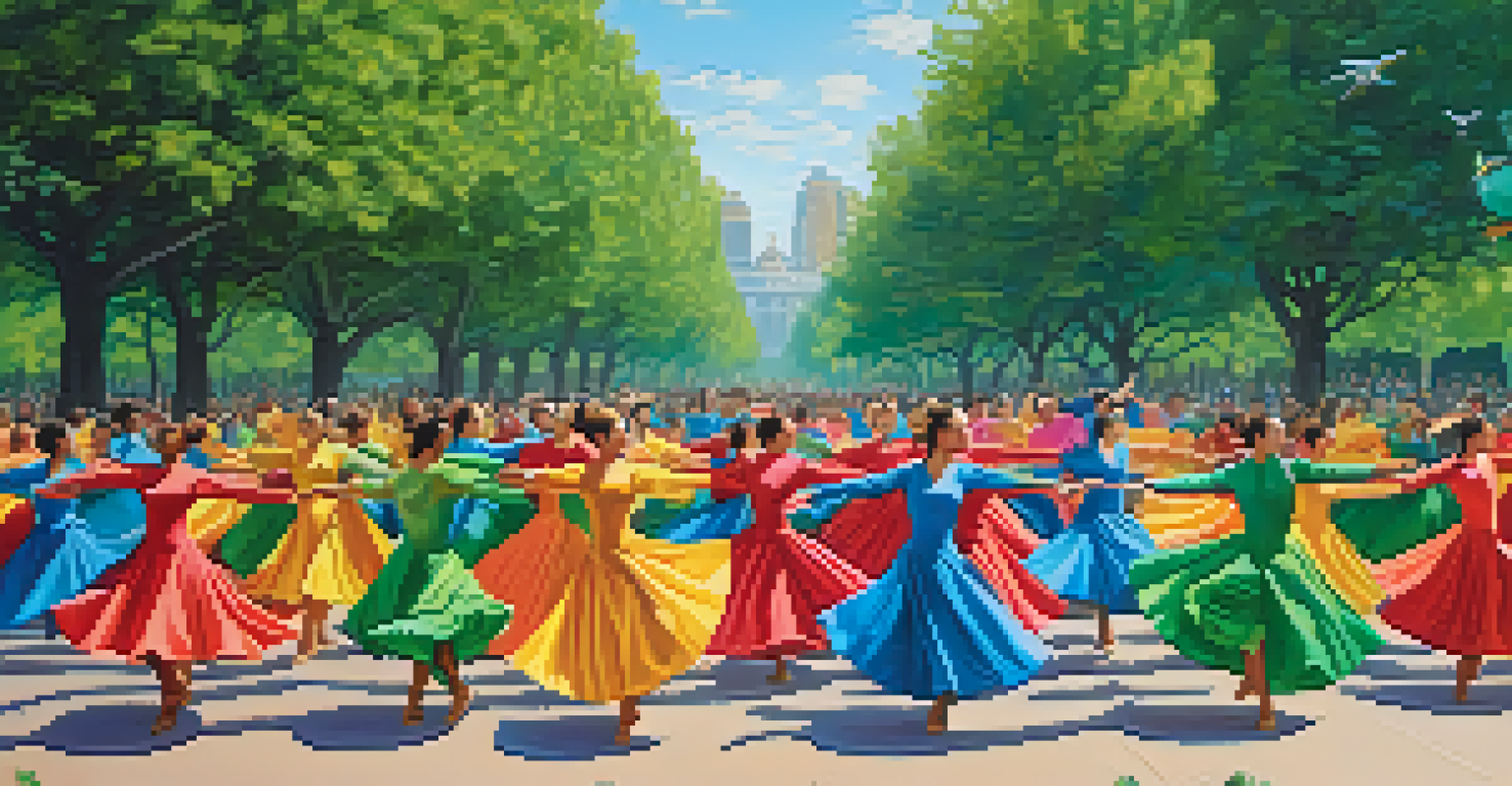The Intersection of Dance and Environmental Science

How Dance Reflects Environmental Awareness
Dance has an incredible ability to convey messages, and when it comes to environmental awareness, it's no different. Through movement, choreographers can highlight the beauty of nature and the urgent need for its preservation. For instance, a contemporary dance piece might mimic the flowing of rivers or the rustling of leaves, creating a visceral connection to the environment.
Dance is the hidden language of the soul.
Moreover, many dance performances today incorporate themes of climate change and ecological degradation. This not only raises awareness but also invites audiences to reflect on their relationship with nature. As dancers portray the impact of pollution or deforestation, spectators are prompted to consider how their actions affect the planet.
By using the universal language of movement, dance can evoke emotions that statistics or speeches often can’t. This emotional engagement can inspire action, turning viewers into advocates for environmental change. In this way, dance serves as a powerful tool for promoting ecological literacy and inspiring a collective response.
The Role of Choreography in Environmental Storytelling
Choreography isn't just about creating beautiful movement; it's also a way to tell stories, including those about our environment. Dancers can embody natural elements and phenomena, allowing audiences to experience environmental narratives on a deeper level. For example, a dance interpretation of a forest fire can convey urgency and loss, using movement to illustrate the destruction caused by climate change.

Incorporating environmental themes into choreography challenges dancers and choreographers to think critically about their bodies in space and how they relate to the world around them. This process often leads to innovative movements that reflect the fragility of ecosystems. The result is a form of art that not only entertains but educates.
Dance as a Tool for Awareness
Dance effectively conveys messages about environmental issues, fostering emotional connections that inspire action.
As choreographers experiment with these themes, they are also expanding the boundaries of dance itself. By merging art and science, they create a dialogue that can transcend the stage, reaching audiences who may not have previously engaged with environmental issues. This artistic storytelling can be a catalyst for change, encouraging viewers to take action.
Dance as a Medium for Activism
Dance has a long history of being used as a form of protest and activism. In the context of environmental issues, dancers are increasingly using their platforms to advocate for sustainability and conservation. Whether it’s through flash mobs in public spaces or organized dance protests, these movements can draw significant attention to pressing ecological concerns.
Art is not a mirror held up to reality but a hammer with which to shape it.
For instance, a group of dancers might perform at a local park to raise awareness about its preservation, using their bodies to symbolize the beauty and importance of green spaces. These performances can create a memorable experience that resonates with the audience, making the message of environmental stewardship more impactful.
Additionally, dance can unite communities around a common cause, fostering a sense of collective responsibility. When people come together to dance for the environment, it creates a shared experience that can strengthen community bonds and promote collaborative action toward sustainability.
The Intersection of Dance and Nature
Nature has always been a source of inspiration for artists, and dancers are no exception. Many dance companies are now taking their performances outdoors, using natural landscapes as both their stage and inspiration. This practice not only enhances the visual impact of the performance but also emphasizes the connection between dance and the environment.
Performing in natural settings allows dancers to engage with the elements—wind, water, and earth—creating a multisensory experience for both performers and audiences. For example, a dance performed on a beach can incorporate the sound of crashing waves and the feel of sand beneath their feet, deepening the connection to the environment.
Choreography Tells Environmental Stories
Through choreography, dancers can embody natural elements, offering audiences a profound understanding of ecological narratives.
Moreover, these outdoor performances can serve as a reminder of the beauty that surrounds us and the need to protect it. By bringing art into nature, dancers are not only showcasing their talents but also inviting the audience to appreciate the world around them, fostering a deeper understanding of environmental issues.
Educational Programs Combining Dance and Environmental Science
Educational initiatives that combine dance with environmental science are becoming more prevalent, providing an engaging way for students to learn about ecology. Workshops that integrate movement and environmental education can help students understand complex concepts through kinesthetic learning. This hands-on approach makes the material more relatable and memorable.
For instance, a workshop might involve students creating a dance that represents the water cycle, allowing them to embody and visualize the process. This method not only enhances their understanding of scientific principles but also encourages creativity and collaboration among peers.
Such programs highlight the importance of interdisciplinary learning, showing how art and science can work together to inspire the next generation. By fostering an appreciation for both dance and environmental science, these initiatives promote a holistic understanding of the world and the importance of sustainability.
Emphasizing Sustainable Practices in Dance
As the conversation around environmental sustainability grows, the dance community is taking steps to incorporate eco-friendly practices into their productions. This includes everything from using sustainable materials for costumes to reducing waste during performances. By adopting these practices, the dance industry can set an example for other artistic fields.
For example, some companies are opting for costumes made from recycled fabrics or natural dyes, showcasing that beauty can be achieved sustainably. Additionally, reducing the carbon footprint of touring by using green transportation options or performing locally can significantly impact the environment.
Sustainability in Dance Practices
The dance community is increasingly adopting eco-friendly practices, demonstrating that art can be both beautiful and environmentally responsible.
Sustainable practices in dance not only benefit the planet but also resonate with audiences who value eco-consciousness. When viewers see a performance that emphasizes sustainability, it reinforces the message that art can be both beautiful and responsible, encouraging them to consider their own environmental impact.
The Future of Dance and Environmental Advocacy
Looking ahead, the intersection of dance and environmental advocacy is poised to grow even stronger. As climate change continues to impact our world, artists will likely find new ways to express their concerns and inspire action through movement. The future of dance could see even more innovative collaborations between scientists, artists, and activists.
Emerging technologies, such as virtual reality and interactive media, may also play a role in how dance addresses environmental issues. Imagine a dance performance that immerses the audience in a virtual world showcasing the beauty of nature and the dire consequences of inaction. This fusion of technology and art could create powerful experiences that resonate deeply with audiences.

Ultimately, the continued dialogue between dance and environmental science holds immense potential. By harnessing the power of movement and creativity, the dance community can not only raise awareness but also inspire a collective movement toward a more sustainable future.